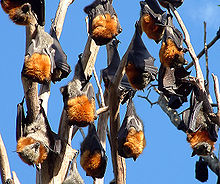
Pteropus poliocephalus

The grey-headed flying fox (Pteropus poliocephalus) is a megabat native to Australia. The species shares mainland Australia with three other members of the genus Pteropus: the little red P. scapulatus, spectacled P. conspicillatus, and the black P. alecto. The grey-headed flying fox is endemic to the south-eastern forested areas of Australia, principally east of the Great Dividing Range. Its range extends approximately from Bundaberg in Queensland to Geelong in Victoria, with outlying colonies in Ingham and Finch Hatton in the north, and in Adelaide in the south. In the southern parts of its range it occupies more extreme latitudes than any other Pteropus species. A description of the species was published by Coenraad Temminck in his 1825 monograph of mammals. Hybridisation with the species Pteropus alecto has been noted where their ranges intersect. The common names for Pteropus poliocephalus include grey-headed kalong, the entry in Gould's Mammals of Australia (1863) gave the bat the title grey-headed vampire. The grey-headed flying fox is the largest bat in Australia. The overall colour of the pelage is a dark-grey body with a light-grey head, separated by a reddish-brown collar. The fur on the body is long and streaked with grey, the broad and well defined collar completely encircles the neck with hair that is golden orange in tone.A unique characteristic among bats of the genus Pteropus is fur on the legs that extends all the way to the ankle. Adults may have a wingspan reaching one metre in length and be up to one kilogram in weight.Weight generally varies between 600 and 1000 grams, with an average of 700 g. The combined length of the head and body is from 230 to 290 mm.The forearm length is a range from 138 to 180 mm. The length of the ear from the tip to base is 30 to 37 mm. Like many megachiropterans, the species lacks a tail, all of these bats possess claws on its first and second digits. The head is simple in form, with the characteristic 'dog-like' appearance of the genus.Since it does not echolocate, it lacks the tragus or leaf ornamentation found in many species of Microchiroptera. It relies on smell and, predominately, sight to locate its food (nectar, pollen and native fruits) and thus has relatively large eyes for a bat. The voice of P. poliocephalus consists of a complex series of squeals and screechings. They will flap their wings in hot weather, using blood pumped through the patagium to cool the body temperature. The grey-headed flying fox is long-lived for a mammal of its size. Individuals reportedly survived in captivity for up to 23 years, and a maximum age of up to 15 years seems possible in the wild.
